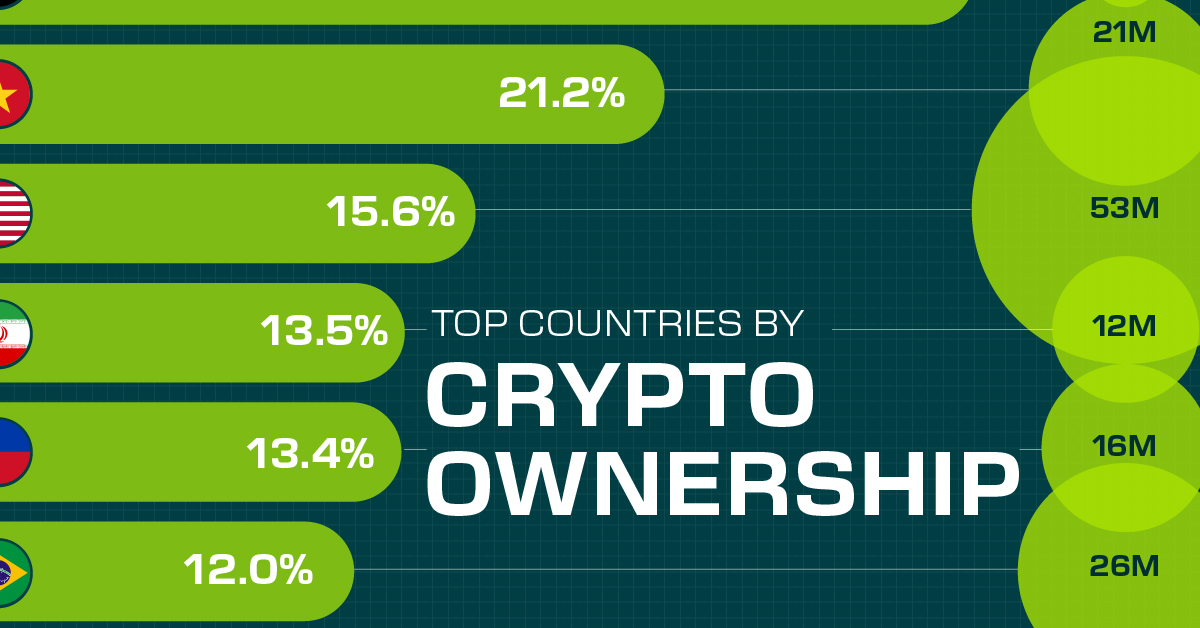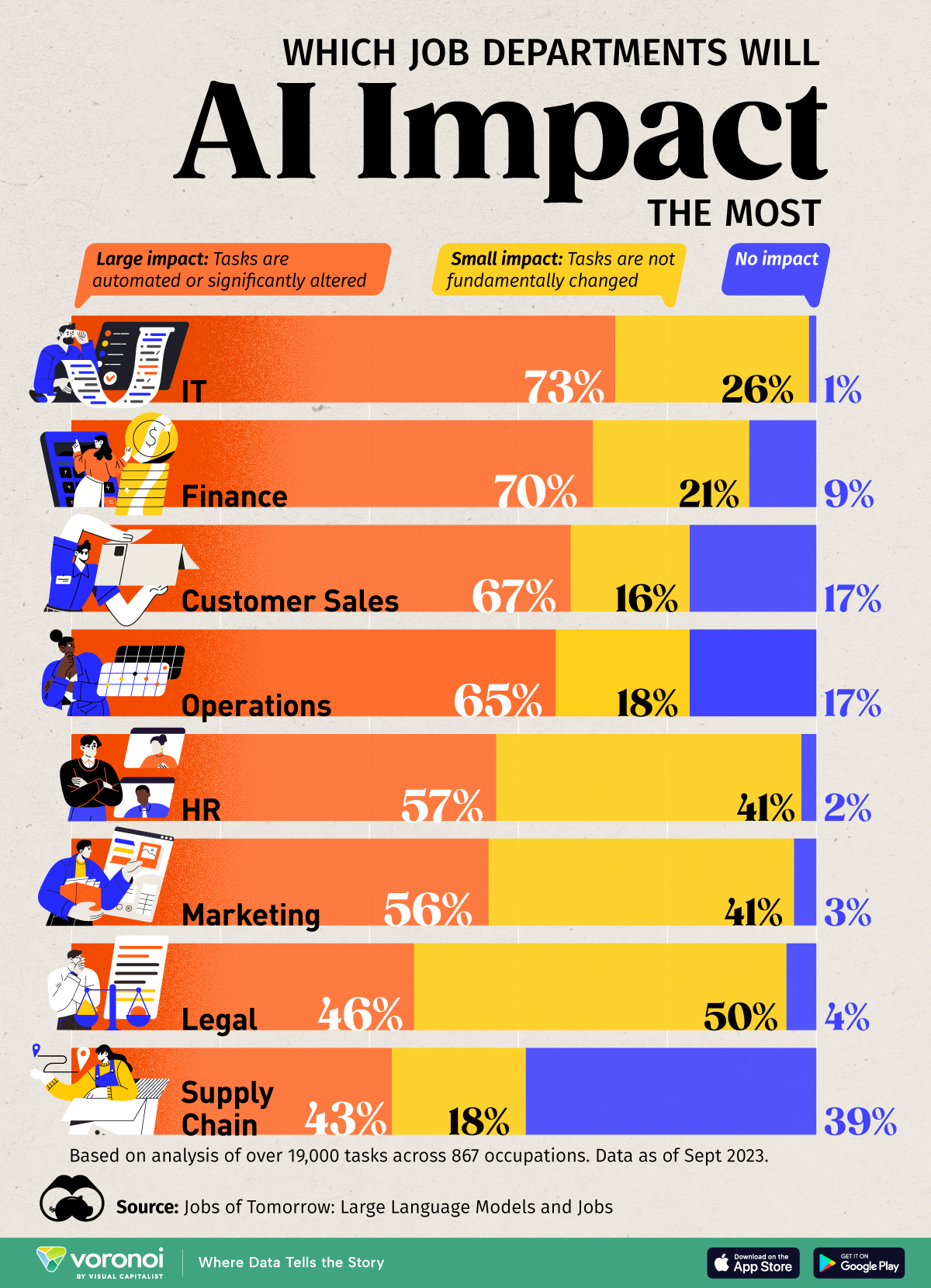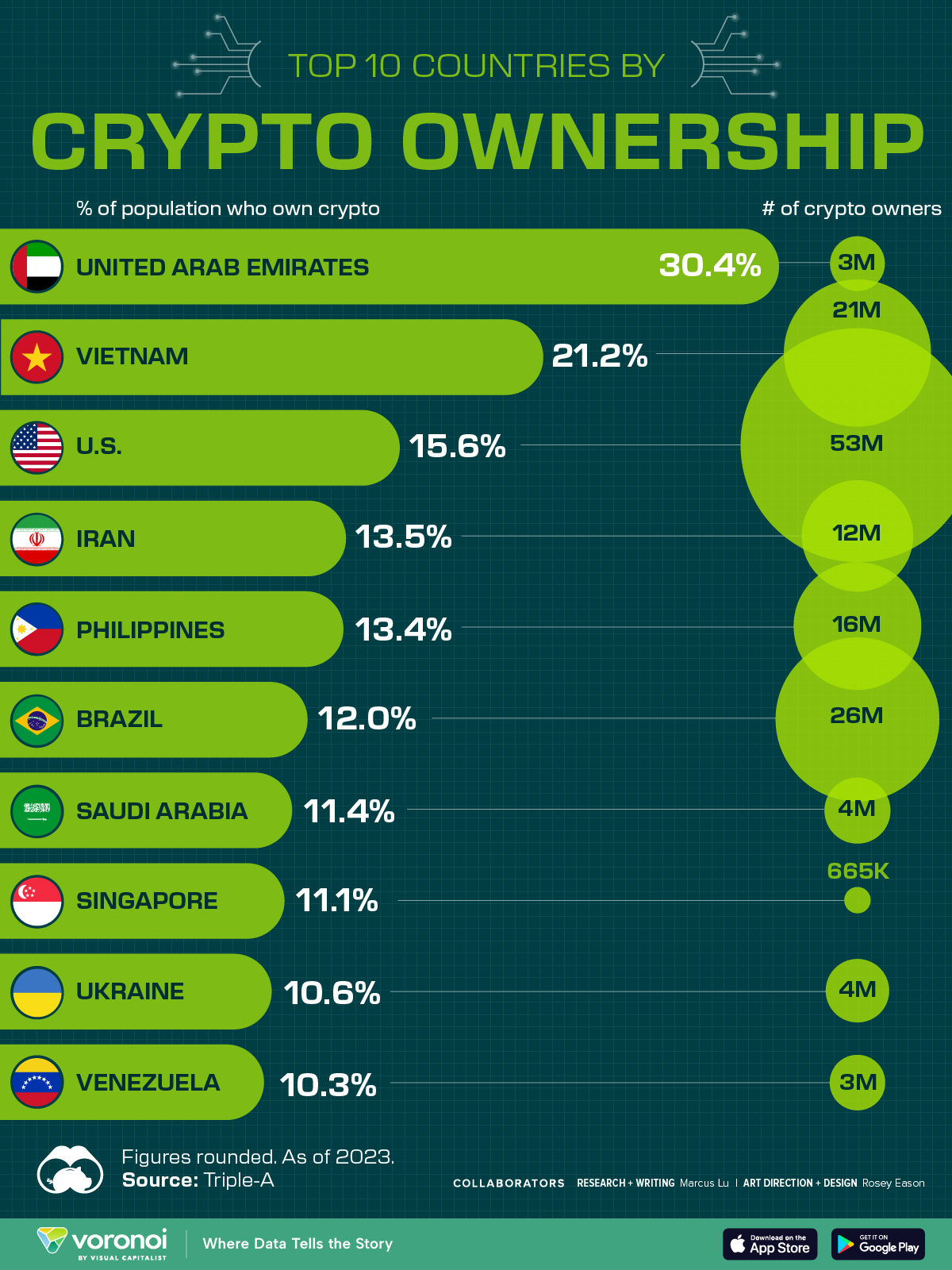Technology
Charted: The Jobs Most Impacted by AI
![]() See this visualization first on the Voronoi app.
See this visualization first on the Voronoi app.
Charted: The Jobs Most Impacted by AI
This was originally posted on our Voronoi app. Download the app for free on iOS or Android and discover incredible data-driven charts from a variety of trusted sources.
Large language models (LLMs) and other generative AI tools haven’t been around for very long, but they’re expected to have far-reaching impacts on the way people do their jobs. With this in mind, researchers have already begun studying the potential impacts of this transformative technology.
In this graphic, we’ve visualized the results of a World Economic Forum report, which estimated how different job departments will be exposed to AI disruption.
Data and Methodology
To identify the job departments most impacted by AI, researchers assessed over 19,000 occupational tasks (e.g. reading documents) to determine if they relied on language. If a task was deemed language-based, it was then determined how much human involvement was needed to complete that task.
With this analysis, researchers were then able to estimate how AI would impact different occupational groups.
| Department | Large impact (%) | Small impact (%) | No impact (%) |
|---|---|---|---|
| IT | 73 | 26 | 1 |
| Finance | 70 | 21 | 9 |
| Customer Sales | 67 | 16 | 17 |
| Operations | 65 | 18 | 17 |
| HR | 57 | 41 | 2 |
| Marketing | 56 | 41 | 3 |
| Legal | 46 | 50 | 4 |
| Supply Chain | 43 | 18 | 39 |
In our graphic, large impact refers to tasks that will be fully automated or significantly altered by AI technologies. Small impact refers to tasks that have a lesser potential for disruption.
Where AI will make the biggest impact
Jobs in information technology (IT) and finance have the highest share of tasks expected to be largely impacted by AI.
Within IT, tasks that are expected to be automated include software quality assurance and customer support. On the finance side, researchers believe that AI could be significantly useful for bookkeeping, accounting, and auditing.
Still interested in AI? Check out this graphic which ranked the most commonly used AI tools in 2023.
Technology
Countries With the Highest Rates of Crypto Ownership
While the U.S. is a major market for cryptocurrencies, two countries surpass it in terms of their rates of crypto ownership.

Countries With the Highest Rates of Crypto Ownership
This was originally posted on our Voronoi app. Download the app for free on iOS or Android and discover incredible data-driven charts from a variety of trusted sources.
This graphic ranks the top 10 countries by their rate of cryptocurrency ownership, which is the percentage of the population that owns crypto. These figures come from crypto payment gateway, Triple-A, and are as of 2023.
Data and Highlights
The table below lists the rates of crypto ownership in the top 10 countries, as well as the number of people this amounts to.
| Country | % of Population Who Own Crypto | # of Crypto Owners |
|---|---|---|
| 🇦🇪 United Arab Emirates | 30.4 | 3M |
| 🇻🇳 Vietnam | 21.2 | 21M |
| 🇺🇸 U.S. | 15.6 | 53M |
| 🇮🇷 Iran | 13.5 | 12M |
| 🇵🇭 Philippines | 13.4 | 16M |
| 🇧🇷 Brazil | 12 | 26M |
| 🇸🇦 Saudi Arabia | 11.4 | 4M |
| 🇸🇬 Singapore | 11.1 | 665K |
| 🇺🇦 Ukraine | 10.6 | 4M |
| 🇻🇪 Venezuela | 10.3 | 3M |
Note that if we were to rank countries based on their actual number of crypto owners, India would rank first at 93 million people, China would rank second at 59 million people, and the U.S. would rank third at 52 million people.
The UAE Takes the Top Spot
The United Arab Emirates (UAE) boasts the highest rates of crypto ownership globally. The country’s government is considered to be very crypto friendly, as described in Henley & Partners’ Crypto Wealth Report 2023:
In the UAE, the Financial Services Regulatory Authority (FSRA-ADGM) was the first to provide rules and regulations regarding cryptocurrency purchasing and selling. The Emirates are generally very open to new technologies and have proposed zero taxes for crypto owners and businesses.
Vietnam leads Southeast Asia
According to the Crypto Council for Innovation, cryptocurrency holdings in Vietnam are also untaxed, making them an attractive asset.
Another reason for Vietnam’s high rates of ownership could be its large unbanked population (people without access to financial services). Cryptocurrencies may provide an alternative means of accessing these services without relying on traditional banks.
Learn More About Crypto From Visual Capitalist
If you enjoyed this post, be sure to check out The World’s Largest Corporate Holders of Bitcoin, which ranks the top 12 publicly traded companies by their Bitcoin holdings.
-

 Markets5 days ago
Markets5 days agoVisualizing Global Inflation Forecasts (2024-2026)
-

 Green2 weeks ago
Green2 weeks agoThe Carbon Footprint of Major Travel Methods
-

 United States2 weeks ago
United States2 weeks agoVisualizing the Most Common Pets in the U.S.
-

 Culture2 weeks ago
Culture2 weeks agoThe World’s Top Media Franchises by All-Time Revenue
-

 Best of1 week ago
Best of1 week agoBest Visualizations of April on the Voronoi App
-

 Wealth1 week ago
Wealth1 week agoCharted: Which Country Has the Most Billionaires in 2024?
-

 Markets1 week ago
Markets1 week agoThe Top Private Equity Firms by Country
-

 Jobs1 week ago
Jobs1 week agoThe Best U.S. Companies to Work for According to LinkedIn











